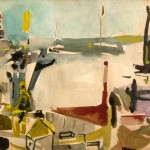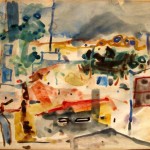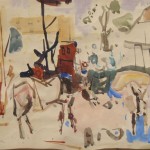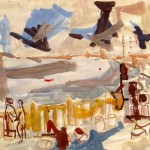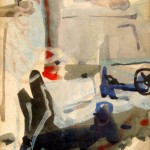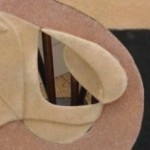Robert Baser was one of the artists who left the Artists Association after the Independence War in 1949. The group of artist who left the association was called the “Separatists”.
Robert Baser was born in Athens. His father was a leather retailer that traveled many times to Turkey for commerce purposes. As a result, he and his family moved to Istanbul when Robert was merely a child. In 1923, when a war began between Turkey and Greece, his family returned to Athens where Robert finished his studies in Athens Art Academy.
As a student, he participated in several group exhibitions and won the first place due to his water-color sketches. Robert was also the youngest student to win the National Award.
When Baser finished his academic studies, he made a living from graphic art works and paintings for commercial purposes. An example for one of his works is a cover for cigarette box called “Paps-Starto”.
In the early 30’s he met a young Jewish girl that arrived from Poland to Greece, they decided to marry and immigrate to Palestine. They tried to get to Palestine with a boat but in the last moment they found out they can’t do “Aliya” (approval to immigrate to Palestine). Therefore they arrived to Palestine through Lebanon. They arrived to the Promised Land in 1934 when Baser was 26 years old. After his arrival, Baser joined the just founded Painters Association. The first exhibition was presented in Café Hillel in Tel Aviv. When the Second World War began, Baser was one of the firsts to volunteer to the British army.
In 1940 he received a Certificate of Appreciation from the British army for his achievements in art. When he was sent to the war front, he jumped from the train and escaped his duties. He was defined as a renegade and sent to evaluation. He explained that he can’t stand to see all the blood and was released from all his duties after a month in prison.
Robert Baser was one of the artists who left the Artists Association after the Independence War in 1949. The group of artist who left the association was called the “Separatists”. The reason for their leaving was the problematic chairman (Zariski) who led the painters to a clear verbal-abstract painting style. Zariski was known as a charismatic but problematic chairman, and this led him to acquire several enemies. The “Separatists” founded the group later named “New Horizons”. This group presented modern art for the Israel public, an act that was revolutionary at the time.
In the 50’s “New Horizons” group came apart and its members went each on their own way. Only then Baser made his dream come true and moved to Paris. In 1954, Baser and his wife Rebecca, a known jewelry designer, packed they ownings and immigrated to France. In Paris Baser began to sculpture for the first time. For lack of money, at the beginning he sculptured with trash he collected in the street. The Parisian art commune welcomed Baser quickly and he became part of the Parisian Avant-Gard group which included 180 members all over the world.
After 7 years Baser started missing Israel and he came back and made his residency in Safed’s old town. After his return, he presented his works in the National Museum in Jerusalem and the Modern Art Museum in Tel Aviv. Additionally, Baser presented his works every year in Athens. At the beginning of his career, Baser was a figurative painter but gradually he found himself attracted to the abstract. Baser was known for his water color Mediterranean Sea paintings. He painted views from Jaffa to Spain. His sculptures showed social thinking that critics inequality; these works showed how humanist Baser was. Baser participated several single exhibition in several museums and won many awards such as Dizengoff Award in 1946 and 1969, and Monaco Award in 1966.
In her book, “Robert Baser – Water Colors”, Gila Blas writes: “if there was ever a doubt about the existence of Middle Eastern painting, then Robert Baser’s work eliminates this doubt. From Athens, where he was born, this young man arrived to Palestine, a different shore in the same see, and so when his painters’ friends came from Europe and were shocked by the Middle Easter sun, Baser felt at home with this familiar climate”.
Baser became a known name in the Israeli art, together with Nahum Guttmann and Shimshon Holtzman. However, while Holtzman experienced difficulties to abandon the shapes, Guttmann’s sense of humor entered his paintings and made them seem as stories. Baser paintings were pure in compare to that; the brush, the color, the paper and nothing but the knowledge how to apply the color. It was as though no one could have expressed the sea and the Mediterranean climate better than Robert Baser.
“All my life I sculptured in Bronze, Cast, synthetic materials and almost from anything. I created so many sculptures. Before 30 years I presented my works with Vasarely and César. Sculptures I created with kinetic elements, do you understand? I’m a sculptor. A painter and sculptor”.
Question: you said “sculptor” twice. Why is that?
“Because here in Israel people don’t know I’m a sculptor. They only know that I’m water color painter. But in Paris they know I’m a sculptor”.
Question: Does it bother you that people don’t know you are a sculptor?
“It’s like having a part in your body you can’t see”.
Source: Zomet Hasharon.
Robert Baser received recognition as a sculptor, as he wished, in 1969, when one of his Cast sculptures brought him the Dizengoff Award.
In 1990, Baser won the Discount Award. The judges explained the decision: “Robert Baser is successful painter in several areas. His water color paintings have an important role in the history of Israeli art. They are characterized in bright and rich colors. They rightfully express the qualities of local light. Baser’s paintings are filled with hedonism and joy of life. These qualities make Baser one of the most important artists in Israel that capture the qualities of the Mediterranean Sea” (Globes, 1990).

